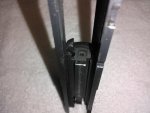For many years a Canadian built, alloy frame, Para Ordnance P13 was my duty gun, and it ran like the proverbial Swiss watch as long as I changed out the recoil springs often enough. However, recently, it has started having two unusual malfunctions that I have been unable to cure, or diagnose, and yes, I did change the recoil spring.
The malfunctions do not correspond with any particular magazine, and if I use the magazine that just malfunctioned in another Para pistol, it works just fine. The malfunctions occur regardless of which magazine I am using.
Malfunction #1 is the stovepipe of a loaded round out of the magazine. Pistol works fine, then a loaded round will stovepipe.
Malfunction #2 is a slide over base stoppage. Just as the bullet enters under the hood of the barrel, the rear of the loaded round will push down into the magazine. The common malfunction clearing of "tap, rack, assess" does not clear this malfunction because the case rim is not under the extractor.
I have used Federal 230 grain Hydrashock. I am using the same lot of ammo that has worked fine for many years.
I also use Hornady 230 grain +p Critical Defense, or my hand-load round consisting of 5.1 grains of HP-38 over a 230 grain FMJ bullet. In all other pistols, these rounds, and the magazines I was using function flawlessly.
Normally, installation of new #22 pound recoil spring solves problems, but this time, it didn't matter. So I put the older spring back in. The fresh spring seemed to increase the frequency of malfunctions, so my first suspicion would be to go to a lower weight recoil spring.
Recoil springs I have in stock for this pistol are Wolff 22 pound, Nighthawk 20 pound, and some of the older more "tired" springs that I replaced but saved "just in case".
I meticulously cleaned the pistol, removing extractor, firing pin, and cleaning down deep in those recesses too.
The extractor looks good and it's lower edge has just barely had the sharp angles rounded so the rounds can slip under it more easily.
Has anyone had to deal with this, or does anyone have ideas for possible solutions. I'm really disappointed that my formerly ultra-reliable duty pistol is starting to get cranky, and obviously, I won't carry it until I can get this all squared away.
I called Para USA, and they just don't seem to want anything to do with the Canadian built guns. I was really disappointed in Para USA's attitude...it amounted to "find a gunsmith". I didn't even get to talk to anyone in their shop.
Any help will be greatly appreciated.
The malfunctions do not correspond with any particular magazine, and if I use the magazine that just malfunctioned in another Para pistol, it works just fine. The malfunctions occur regardless of which magazine I am using.
Malfunction #1 is the stovepipe of a loaded round out of the magazine. Pistol works fine, then a loaded round will stovepipe.
Malfunction #2 is a slide over base stoppage. Just as the bullet enters under the hood of the barrel, the rear of the loaded round will push down into the magazine. The common malfunction clearing of "tap, rack, assess" does not clear this malfunction because the case rim is not under the extractor.
I have used Federal 230 grain Hydrashock. I am using the same lot of ammo that has worked fine for many years.
I also use Hornady 230 grain +p Critical Defense, or my hand-load round consisting of 5.1 grains of HP-38 over a 230 grain FMJ bullet. In all other pistols, these rounds, and the magazines I was using function flawlessly.
Normally, installation of new #22 pound recoil spring solves problems, but this time, it didn't matter. So I put the older spring back in. The fresh spring seemed to increase the frequency of malfunctions, so my first suspicion would be to go to a lower weight recoil spring.
Recoil springs I have in stock for this pistol are Wolff 22 pound, Nighthawk 20 pound, and some of the older more "tired" springs that I replaced but saved "just in case".
I meticulously cleaned the pistol, removing extractor, firing pin, and cleaning down deep in those recesses too.
The extractor looks good and it's lower edge has just barely had the sharp angles rounded so the rounds can slip under it more easily.
Has anyone had to deal with this, or does anyone have ideas for possible solutions. I'm really disappointed that my formerly ultra-reliable duty pistol is starting to get cranky, and obviously, I won't carry it until I can get this all squared away.
I called Para USA, and they just don't seem to want anything to do with the Canadian built guns. I was really disappointed in Para USA's attitude...it amounted to "find a gunsmith". I didn't even get to talk to anyone in their shop.
Any help will be greatly appreciated.

